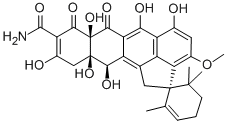Description
Viridicatumtoxin in a mycotoxin originally isolated from
Penicillium that has diverse biological activities, including antimicrobial, cytotoxic, and toxic properties. It inhibits the growth of
B. subtilis,
M. luteus,
C. perfringens,
B. fragilis, and methicillin-resistant
S. aureus (MRSA; MICs = 0.39-1.56 μg/ml), as well as
C. albicans,
S. cerevisiae,
M. racemosus,
A. niger, and
P. chrysogenum (MICs = 6.2-25 μg/ml), but has no activity against
M. smegmatis,
E. coli,
K. pneumoniae,
P. aeruginosa, or
S. marcescens (MICs = >100 μg/ml). Viridicatumtoxin inhibits the production of polyprenyl alcohols by
S. aureus undecaprenyl pyrophosphate (UPP) synthase,
E. coli octaprenyl pyrophosphate synthase (OPS), and
S. cerevisiae dehydrodolichyl pyrophosphate (DedoIPP) synthase
in vitro (IC
50s = 3.1, 21, and 71 μM, respectively). It has cytotoxic effects against human Jurkat T (IC
50 = 4.92 μM), chronic lymphocytic leukemia (CLL; LC
50 = 0.7-3.5 nM), and bone marrow-derived HS-5 stromal cells. Viridicatumtoxin is toxic to rats and mice when administered intraperitoneally (LD
50s = 80 and 90 mg/kg, respectively) and to rats when administered
via gastric intubation (LD
50 = 122.4 mg/kg), but not to rats or mice when administered orally or through subcutaneous injection.
Uses
Viridicatumtoxin is a tetracycline-like metabolite produced by several species of Penicillium, first isolated in 1976 as a mycotoxin. Initial testing revealed that viridicatumtoxin caused myocardial deterioration, renal tubule necrosis and spleen atrophy. Analogous to the related tetracyclines, viridicatumtoxin was found to be a potent antibacterial, with activity against S. aureus including MRSA and QRSA strains. Little has been published on the mode of action of viridicatumtoxin.

